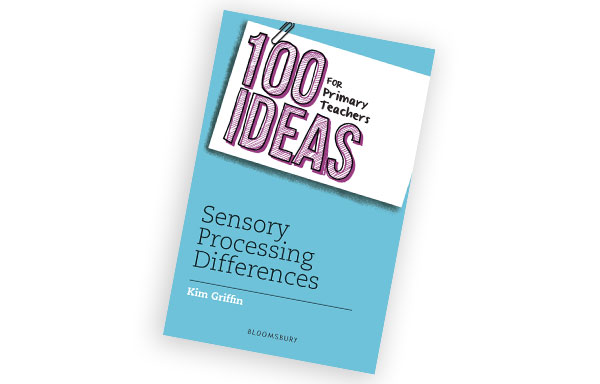Primary teachers - do you need some sensory inspiration?

Kim Griffin's first book with Bloomsbury, ‘100 Ideas for Primary Teachers: Sensory Processing Difficulties’ is now available.
The 100 ideas series is designed to give teachers a handbook of practical ideas and tips. Each one-page idea explores a specific topic. The book is designed to be used a quick reference tool for each topic. Ideas do not need to be read in order and a teacher can jump to the ideas that are most relevant for them.
Kim’s book focusses specifically on sensory processing. Parts 1 and 2 explore basic sensory terms and concepts and how these apply to the classroom. Parts 3 and 4 consider how to choose relevant sensory supports and any special considerations. The rest of the book explores different sensory strategies and equipment which can help to support common sensory differences in the classroom.
Teaching tips explain the best way to run an activity or put an idea into practice with additional advice for extending extend ideas and developing your knowledge further. Bonus ideas, for some topics, are included to help with implementation. Here’s an example of one of the 100 ideas.
Idea 77 Ear defenders
‘We used the ear defenders during assembly and lunchtimes as they really helped Oscar to stay in the space and engage.’
Ear defenders, or noise-blocking headphones, are a common piece of sensory equipment. They can be helpful for pupils who are sensitive to sounds. They are readily available commercially.
The available products are all similar price points, and you will easily be able to find them in sensory catalogues and general suppliers (e.g. Amazon). Some pupils prefer ear plugs over ear defenders. Ear defenders won’t work for all pupils, as some pupils don’t like wearing them as they muffle sounds.
Typically, pupils will use the ear defenders during noisier periods. This might be during music lessons, assembly or when in the lunch hall. Sometimes, pupils will wear them when they need to sit and focus on work. Other pupils will use them when their classmates start to become louder.
The pupil should be reasonably independent in putting these on and off. Some pupils might need a reminder to put them on. Other pupils will independently decide when they will use them.
More recently, noise-cancelling headphones are being used by some pupils. These can be expensive, and typically parents have purchased them. The noise-cancelling feature can be used with or without music playing.
Teaching tip
Teach the pupil to access the headphones when they need them. Have them freely available for the pupil to access and put on and off.
Bonus idea
For pupils with larger heads, sometimes gardening noise protection headphones are more comfortable as these come in adult sizes.
If you would like to read the other 99 ideas, then we have a free copy to giveaway with next month’s The Link magazine!
Alternatively you can purchase the book now from a number of book sellers including Bloomsbury and Amazon.
|
Kim Griffin Kim is an occupational therapist with 20 years’ experience supporting children, their families and teachers. She currently provides online training, support, and online sensory assessments via her website GriffinOT.com. |